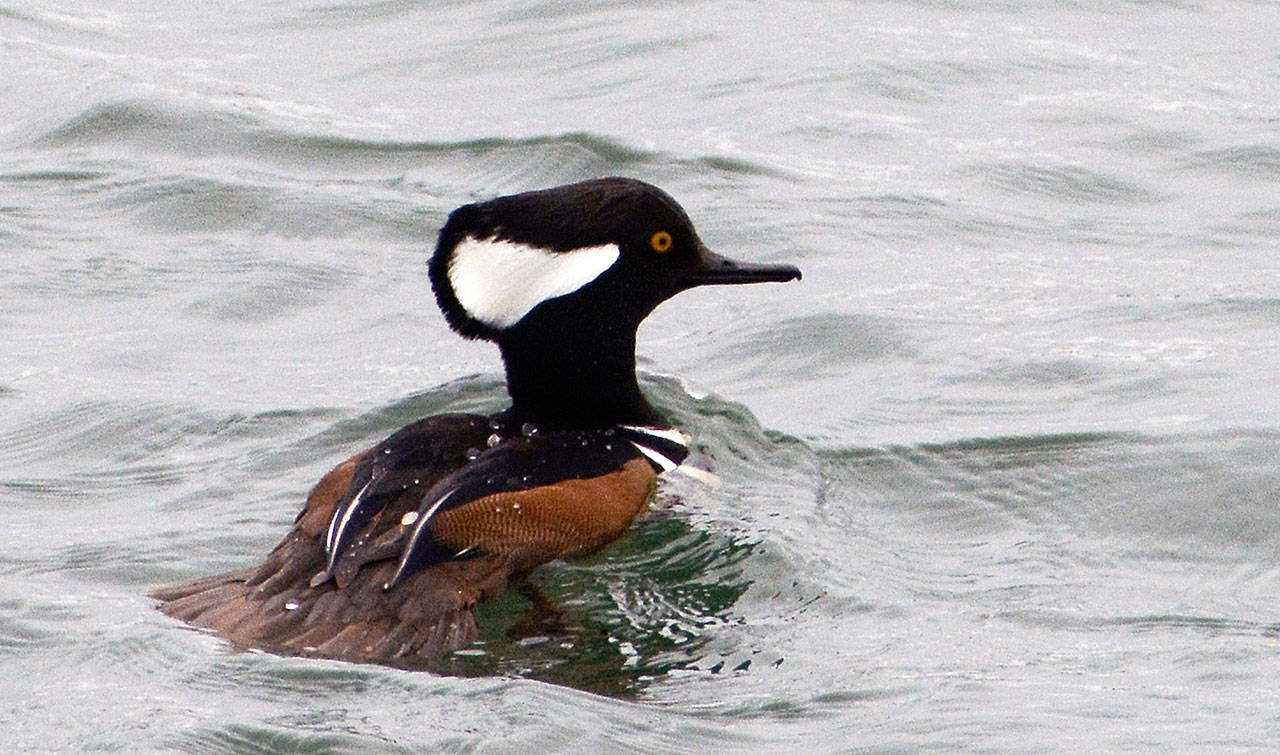The Grays Harbor Audubon Society is lucky to have an enthusiastic birder in Judith Taylor who is also a pretty decent photographer, so I am pleased when I can use one of her photos to illustrate a bird I am featuring in this column. It always helps when the bird being featured is colorful or has some distinguishing characteristics and this one has both. The adult male in breeding plumage is a flashy specimen as you can see. It would be really hard to miss him in a crowd! So pull up a chair and learn a bit more about this duck.
General Description: Hooded Mergansers are the smallest of the mergansers commonly found in the state of Washington but can provide nearly endless entertainment as they go about their business. The one in the photo is a male in breeding plumage. Non-breeding males, females, and immature males are more subdued colors of course, a sort of grayish-brown but lighter below and darker on the back. The large white patch on the breeding males head is part of a crest that can be spread like a fan making the white patch really stand out. Both sexes are about 16 to 19 inches in length, with a wing span of 24 to 26 inches, and weighing 16 to 31 ounces. Mergansers have a narrow serrated bill which makes it easier to hold onto prey items.
Habitat: In winter these ducks can be found in protected saltwater coastal estuaries, bays and tidal creeks. They can also be seen on woodland ponds, swamps and marshes. They prefer low elevation freshwater lakes, ponds, sloughs and slow-moving rivers, for breeding habitat. They are cavity-nesting ducks so look for hollows in trees or even nestboxes near ponds.
Behavior: Most pairs form among small flocks on wintering grounds, so expect to see lots of bowing and bobbing of heads as well as fanning of the males crest as each male tries to out-perform the next. They also make low, gravelly groaning noises. Hooded Mergansers dive for their food so keep your eyes peeled for their splash as they dive.
Diet: With a more diverse diet than that of other mergansers, the Hooded Merganser eats small fish, crustaceans and aquatic insects. The young are especially in need of the insects. Hooded Mergansers have underwater vision, a real plus in the food-gathering.
Nesting: Female Hooded Mergansers start looking for potential nest sites at about one year but don’t breed until their second year. Pair bonds last from winter through the beginning of incubation. They nest in cavities in a tree between 10 and 50 feet off the ground or they may use a nestbox, making do with the materials already in the cavity then using their own plucked down to line the nest. The female lays 10 to 12 eggs. She commonly adds her own eggs to those of another cavity-nesting duck. When incubation begins the male leaves the nesting area so incubation is by the female only, lasting 26 to 41 days and averaging 33 days. Within 24 hours of hatching the young jump out of the nest, landing among the leaves or sometimes in the water if the nest is close enough to it. They all head to the water to join their mother. She leads them to food-rich areas and tends to their needs for a few weeks but abandons them before they can fly, at about 70 days of age.
Migration: Hooded Mergansers migrate short distances. They winter in coastal areas from about November through April.
Conservation Status: In recent decades the population of Hooded Mergansers has gradually increased, probably due to the use of nestboxes and wetland restoration efforts. They still need monitoring due to habitat destruction and the loss of nesting cavities. They are also slow to colonize new breeding areas, making it important to save the current breeding areas.
When and Where to Find on Grays Harbor: In the winter these ducks can be seen in protected areas, such as the Westport Marina, where this photo was taken, or in smaller brackish or freshwater ponds. In the summer they can be found throughout wooded lowland areas throughout the state.



